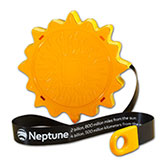
Our Solar System
STEM Activity 7: "Solar System Scale"

 Purpose: Children measure solar system object distances using astronomical units (AU) and learn how long it takes sunlight to reach each planet/object.
Purpose: Children measure solar system object distances using astronomical units (AU) and learn how long it takes sunlight to reach each planet/object.
Supplies needed: Unobstructed space approximately 6’ X 60’. Measuring tape and planet/object cards.
Age level: upper elementary school. For groups of 8-30.
Notes: One child is the Sun and other children hold a card representing a planet/object. Since children are disappointed if they do not have a card to hold, additional moon and asteroid cards were added. Math lesson on ratios for upper elementary or above.
Additional Resources:
- ARES NASA Johnson Space Center. Modeling the Solar System- lessons for grades 3-12: astronomical modeling of orbits and sizes, geologic modeling of planetary interiors, and biological evaluation of what makes planets livable by various creatures.
- Night Sky Network. Worlds of the Solar System- Make a Scale Model.
- Night Sky Network: Pocket Solar System Activity
- NASA Solar System Images
- A Far Out!™ Solar System Mapping Tape can be purchased online from EAI Education or you can make your own using a spool and ribbon.
- NASA-Solar System Math | Answers
- Lunar and Planetary Institute. Planet Distances - Part 2
- National Geographic Planetary Size and Distance Comparison
- Join CosmoQuest in mapping our Solar System. Includes lesson plans for middle school and high school students.
- Do the Sun and Moon Really Rise in the East?
- How Big is Our Galaxy, the Milky Way?
Solar System Update
- 01/25/2021:Puzzling six-exoplanet system with rhythmic movement challenges theories of how planets form . Using a combination of telescopes, including the Very Large Telescope of the European Southern Observatory (ESO’s VLT), astronomers have revealed a system consisting of six exoplanets, five of which are locked in a rare rhythm around their central star. The researchers believe the system could provide important clues about how planets, including those in the Solar System, form and evolve.
- 01/21/2021: Solar System formation in two steps. An international team of researchers from the University of Oxford, LMU Munich, ETH Zurich, BGI Bayreuth, and the University of Zurich discovered that a two-step formation process of the early Solar System can explain the chronology and split in volatile and isotope content of the inner and outer Solar System.
- 10/16/2020: Ultraviolet shines light on origins of the solar system. In the search to discover the origins of our solar system, an international team of researchers, including planetary scientist and cosmochemist James Lyons of Arizona State University, has compared the composition of the sun to the composition of the most ancient materials that formed in our solar system: refractory inclusions in unmetamorphosed meteorites.
- 09/12/19: The rare molecule weighing in on the birth of planets. Astronomers using one of the most advanced radio telescopes have discovered a rare molecule in the dust and gas disc around a young star -- and it may provide an answer to one of the conundrums facing astronomers.
- 05/01/19: Scientists Think They've Found the Ancient Neutron Star Crash That Showered Our Solar System in Gold. Two astronomers analyzed the remnants of radioactive isotopes, or versions of molecules with different numbers of neutrons, in a very old meteorite. Then, they compared those values with isotope ratios produced by a computer simulation of neutron star mergers — cataclysmic stellar collisions that can cause ripples in the fabric of space-time.
- 04/25/19: Next-Generation NASA Instrument Advanced to Study the Atmospheres of Uranus and Neptune. The net flux radiometer is specifically being developed to study the atmospheres of Uranus or Neptune, but could be used on any target with an atmosphere.This type of instrument tells scientists where heating and cooling occurs in a planet’s atmosphere and defines the roles of solar and internal heat sources that contribute to atmospheric motions.
- 04/22/19: Geomagnetic jerks finally reproduced and explained. The Earth's magnetic field experiences unpredictable, rapid, and intense anomalies that are known as geomagnetic jerks. The mechanisms behind this phenomenon had remained a mystery until the recent research. Scientists have now created a computer model for these geomagnetic jerks, and provided an explanation for their appearance.
- 12/20/18: Lucy: The First Mission to Jupiter’s Trojans. During the course of its mission, Lucy will fly by six Jupiter Trojans. This time-lapsed animation shows the movements of the inner planets (Mercury, brown; Venus, white; Earth, blue; Mars, red), Jupiter (orange), and the two Trojan swarms (green) during the course of the Lucy mission. Animation credits: Astronomical Institute of CAS/Petr Scheirich (used with permission)
- 10/04/18: SwRI scientists study Saturn's rings to discover downpour. Using some of the Cassini spacecraft's final measurements, Southwest Research Institute scientists have discovered that complex organics rain down from Saturn's rings into its upper atmosphere. Cassini's final orbits allowed instruments to sample particles in the ring environment, discovering that the inflow of water and other material is much heavier than expected.
- 03/30/18: NASA ScienceCasts: Understanding the Outer Reaches of Earth's Atmosphere. The ionosphere is where Earth's atmosphere gives way to space, and two new NASA missions will work together to uncover its secrets.
- 09/27/17: New Horizons Discoveries Keep Coming- Pluto
- 2/10/17: Astronomers Estimate That The Solar Nebula Lasted 3 To 4 Million Years. By studying the remanent magnetizations in ancient meteorites, astronomers have determined that the solar nebula — the vast of disc of gas and dust that ultimately gave rise to the solar system — lasted around 3 to 4 million years.
- 08/15/16: NASA's Van Allen Probes Catch Rare Glimpse of Supercharged Radiation Belt. Our planet is nestled in the center of two immense, concentric doughnuts of powerful radiation: the Van Allen radiation belts, which harbor swarms of charged particles that are trapped by Earth’s magnetic field. On March 17, 2015, an interplanetary shock – a shockwave created by the driving force of a coronal mass ejection, or CME, from the sun – struck Earth’s magnetic field, called the magnetosphere, triggering the greatest geomagnetic storm of the preceding decade. And NASA's Van Allen Probes were there to watch the effects on the radiation belts.
- 05/17/16: Other Suns got the right spin. Astrophysicists from the Leibniz Institute for Astrophysics Potsdam (AIP) and the Johns Hopkins University in Baltimore have for the first time measured the rotation periods of stars in a cluster nearly as old as the Sun and found them to be similar. It turns out that these stars spin around once in about twenty-six days – just like our Sun. This discovery significantly strengthens what is known as the solar-stellar connection, a fundamental principle that guides much of modern solar and stellar astrophysics.
- 05/03/16: Evidence Points to Planet Nine Existing, But How Was it Produced?. Earlier this year scientists presented evidence for Planet Nine, a Neptune-mass planet in an elliptical orbit 10 times farther from our Sun than Pluto. Since then theorists have puzzled over how this planet could end up in such a distant orbit.
- 10/27/15: SwRI scientists predict that rocky planets formed from ‘pebbles’
Southwest Research Institute scientists developed a new process in planetary formation modeling that explains the size and mass difference between the Earth and Mars. - 10/16/15: Study questions dates for cataclysms on early moon, Earth.
New work provides surprising new details about the trigger that may have started the earliest phases of planet formation in our solar system. - 9/24/15: 'Fossils' of Galaxies Reveal the Formation and Evolution of Massive Galaxies
An international team led by researchers at Swiss Federal Institute of Technology in Zürich observed massive dead galaxies in the universe 4 billion years after the Big Bang with the Subaru Telescope's Multi-Object InfraRed Camera and Spectrograph (MOIRCS). They discovered that the stellar content of these galaxies is strikingly similar to that of massive elliptical galaxies seen locally. - 9/17/15: Stellar atmosphere can be used to predict the composition of rocky exoplanets
researchers from Instituto de Astrofísica e Ciências do Espaço (IA3) show that the ratio of some heavy elements in a star, like Magnesium (Mg), Silicon (Si) and Iron (Fe), have a crucial influence in the composition of rocky exoplanets. - 8/18/15: Solar System formation don't mean a thing without that spin.
A study of zircons from a gigantic meteorite impact in South Africa casts doubt on the methods used to date lunar impacts. - 07/15/15: Old astronomic riddle on the way to be solved: Absorption of starlight in space. Scientists were able to identify for the first time a molecule responsible for the absorption of starlight in space: the positively charged Buckminsterfullerene, or so-called football molecule.
- 7/23/15: Dartmouth-NASA collaboration reveals new X-ray actions. Potentially destructive high-energy electrons streak into Earth's atmosphere from space, not as Shakespeare's "gentle rain from heaven," but at velocities approaching the speed of light.
Moon
- 01/13/17:When and How Did the Moon Form?